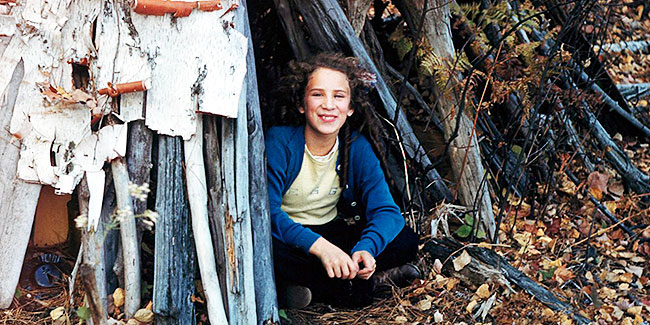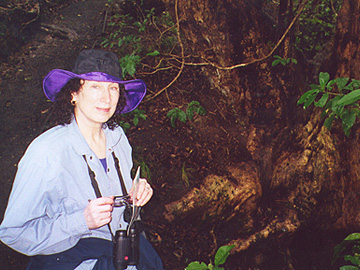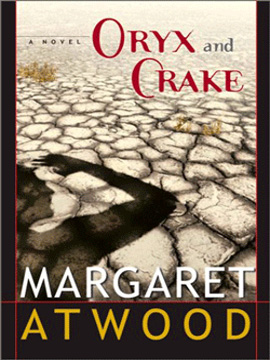Q. What do you like the most about being a writer?
Margaret Atwood. I have no boss. I get to do what I like. I get to help choose the book covers.
Q. What do you like the least about being a writer?
MA. People confuse you with the characters in your books.
Q. Do you prefer to write using a computer, a typewriter or pen and paper?
MA. I never learned to touch type because I mistakenly took home economics instead of typing in high school. And when I tried to teach myself to touch type later I got blisters on my fingers. This was long before there were any computers. So I write in longhand and then I transcribe onto a computer. I used to transcribe onto a typewriter but the computer works better for me because I make mistakes.

A young Margaret Atwood enjoys getting out into nature, as she still does.
Q. What would have been career choice number two if you had decided against becoming a writer?
MA. I actually went through about three or four of them on my way to becoming a writer. I was going to be an artist when I was about ten. Then I was going to be a fashion designer. I used to draw endless pictures of glamorous ladies and beautiful dresses, which I designed. And then I hit high school and we were given the Guidance Book. The Guidance Book was grey and it had five career choices for girls in it in 1951. And they were: airline stewardess, that’s what they were called then, nurse, primary school teacher, secretary and home economist. Those were the things you could be. I didn’t want to be any of them. But the home economist got paid the most. So if I had to be something I didn’t want to be, I figured I might as well make more money at it. So I took home economics. That’s how I ended up in that. Then I was quite good at science so I could then have gone off on that path. But I didn’t do any of those things as it turned out.
Q. What novels do you remember reading in high school?
MA. I won Pride and Prejudice as a prize leaving grade eight and going into high school. And I have to say that I went into high school when I was twelve because they still allowed skipping then. I was a midget compared to everybody else because they wouldn’t let you leave the high school until you were sixteen so grade nine was full of sixteen-year olds who hadn’t left yet. So I had a pretty strange first year. Nonetheless, there was Pride and Prejudice to get me through. I joined the Paperback Book Club where they sent you a book every month and the one I remember most was called Donovan’s Brain. It was a science fiction one. That made a deep impression on me. I used to read forbidden books when I was babysitting. So I read two shockers called Forever Amber and Blackboard Jungle. And then I read the real shocker, Peyton Place. That had everything in it. It had sex, incest and varicose veins. All the awful things. So these were the books that I was reading that I wasn’t supposed to be reading. And then there were lots of books that I was reading that I was supposed to be reading. We got a hefty dose of Charles Dickens, George Eliot and Thomas Hardy. And I should also mention Wuthering Heights. We all fell in love with Heathcliff. We inadvisably fell in love with Heathcliff and Mr. Darcy. We had the wrong impression completely that all these monstrous men were actually who we should be with.
Q. Some books are still talked about and relevant years after they are published. What do you think gives a book staying power?
MA. Snappy plot. Well-written. Appeals and connects with something in us. So all of those things. But you never can tell. A book can be very popular for centuries and then just fall from view. For instance a lot of people would be puzzled if you asked them if they had ever read The Pilgrim’s Progress by John Bunyan, which used to be the most popular book of all-time next to the Bible.
Q. Why do you like to choose the book covers?
MA. In one of my other lives I was a painter. Some writers don’t care what their books look like but I do. Sometimes I make the covers myself.
Q. Which books have you made covers for?
MA. Usually for small books of poetry. I’ve probably done about five or six of them.
Q. What do you like to see on the covers?
MA. It depends on the book. Two of them are collages that I made out of French Vogue magazine. I cut out bits and stuck them on. The original Murder in the Dark book cover is made out of a sun block ad. Some little piles of caviar for clouds and part of a bathing suit for the moon.
Q. Do you believe that writers are entitled to freedom of expression in every circumstance or are there certain situations where censorship is necessary?
MA. We have hate laws in this country. So if you are using your writing to target individuals because of their race or religion our government actually prevents that. And considering what got let loose in Nazi Germany I can’t say I’m against it. And everybody’s got their limits. I think one of the lines that people draw advisably is the use of real children in real pornographic films. Because real children are being exploited.
Q. How has being Canadian affected your writing?
MA. When I first began it affected my writing because I thought that I would have to leave the country in order to be published because there just wasn’t much of an audience here or much of a publishing industry. I started writing in high school when I was sixteen so from that time on, and that would have been 1956, from then I went to university and there still wasn’t much of a publishing industry. And it didn’t really kick off until about 1966 and that was the beginning of an explosion. It wasn’t that there was nothing published here. But there was almost nothing. So everybody thought they would have to go to Europe, live in a garret, drink absinthe, smoke cigarettes, get tuberculosis, write works of genius and die young. That’s what we thought. Now you can do all of that here. It was not considered possible to make a living at it here. So I simply assumed that I would have to have another job. And I have a lot of other jobs. The most famous one is my job at the market research company in Toronto, which I transmogrified in The Edible Woman.

Margaret still loves trekking through the woods, usually with her binoculars these days, on the lookout for native birdlife.
Q. In a past interview you mention that you were inspired to write your new book Oryx and Crake while you were bird watching in Australia. What was it that came to you then?
MA. I can’t explain. This is the most difficult thing to tell anybody or to describe, which is how you get your ideas and what they look like when you get them. You just see the shape of a book, and that’s really all I can tell you. It’s just a way of thinking. As mathematics is a way of thinking. As painting is a way of thinking. As music is a way of thinking.
Q. Many young women who read The Edible Woman will recognize the issues of body image in that book. What issues or aspects of Oryx and Crake do you think young people will identify with?
MA. I think they will recognize the world that they live in, almost immediately. Not quite to the same extent, but they will know that take it a few notches further down the road and that’s where we will be.
Q. Can you give an example of a theme in the book that young people will relate to?
MA. Neither Jimmy’s nor Crake’s nor Oryx’s parents are at all satisfactory. So I think they will immediately recognize those moments. Although of course, most of them will have much nicer parents than my characters. At that age, they are certainly all feeling that their parents don’t understand them and aren’t connecting with them. And also the computer games, of course. Especially for boys. The world in which on the one hand there is a lot of affluence but on the other hand a kind of sterility in which reality comes in over the Internet or the TV screen and you’re not sure whether it’s real or not.
Q. How do those issues differ from when you were a teenager?
MA. When I was a teenager we all thought we were going to be blown up by atom bombs. That was seen as the big danger. The Cold War was on. McCarthyism was in full swing in the United States so you also felt that Big Brother was watching you. Then there were a lot of events that intervened, there was the hippie revolution of the late 60’s and the Berlin wall came down in 1989 so the cold War was over. When these kids were growing up it was the 90’s, which was a pretty okay period. There were no major wars going on. People felt pretty safe and the mood was optimistic. And then along came 9/11. So I think these kids have had a shock. They grew up during the 90’s, which, as I said, would lull you into a sense of security pretty much and you’d think life was going to go on as normal. Your major problem might be boredom. But that’s not true anymore. Everyone is suddenly quite alert for quick changes. And I expect the kids have had to think pretty hard about war under what circumstances is war good or preferable to the alternative. They’ve had some choices to make. They’ve also come quite far along the line of the sexual revolution that was kicked off initially by WWI. It’s been a long gradual process. But now of course there’s AIDS. So that’s another danger. They’re probably going to be a lot more microbe conscious than kids were say fifteen years ago, although AIDS was going then too. But now we have even more indifferent microbes. So they probably feel a bit jumpy and uncertain again as to what their roles are. Gender roles are probably still an issue, particularly now for boys. It used to be cut and dried. Girls did this. Boys did that. And a lot of that has been questioned over the years. And girls have come out of that reasonably well. They got to do more things than they used to be able to do. Boys on the other hand probably feel more constrained.
Q. Which books or publications would you recommend that young adults read today that would help them better understand the issues they face?
MA. I would say they should all read The Future of Life by Edmund Osborne Wilson. But read the last chapter first because it’s more hopeful.
Writing Oryx and Crake
By Margaret Atwood
Oryx and Crake was begun in March, 2001. I was still on a book tour for my previous novel, The Blind Assassin, but by that time I had reached Australia.
After I’d finished the book-related events, my spouse and I and two friends travelled north, to Max Davidson’s camp in the monsoon rain forest of Arnheimland. For the most part we were bird-watching. After that we went to Cassowary House, near Cairns, operated by Philip Gregory, an extraordinary
birder; and it was while looking over Philip’s balcony at the red-necked crakes scuttling about in the underbrush that Oryx and Crake appeared to me almost in its entirety. I began making notes on it that night. I hadn’t planned to begin another novel so soon after the previous one. I’d thought I might take some time off, write a few short pieces, clean out the cellar. But when a story appears to you with such insistence you can’t postpone it.
As with The Handmaid’s Tale, Oryx and Crake invents nothing we haven’t already invented or started to invent. Every novel begins with a what if, and then sets forth its axioms. The what if of Oryx and Crake is simply, What if we continue down the road we’re already on? How slippery is the slope? What are our saving graces? Who’s got the will to stop us? As novelist Alistair MacLeod has said, writers write about what worries them, and the world of Oryx and Crake is what worries me right now. It’s not a question of our inventions—all human inventions are merely tools—but of what might be done with them.
This essay was originally written for Bookspan, 2003. It has been reprinted/modified for Faze with permission from Ms. Atwood.

About the book
Margaret Atwood’s classic novel The Handmaid’s Tale is about the future. Now, in Oryx and Crake, the future has changed. The narrator of Atwood’s riveting novel calls himself Snowman. When the story opens, he is sleeping in a tree, wearing an old bedsheet, mourning the loss of his beloved Oryx and his best friend Crake, and slowly starving to death. He searches for supplies in a wasteland where insects proliferate and pigoons and wolvogs ravage the pleeblands, where ordinary people once lived, and the Compounds that sheltered the extraordinary. As he tries to piece together what has taken place, the narrative shifts to decades earlier. How did everything fall apart so quickly? Why is he left with nothing but his haunting memories? Alone except for the green-eyed Children of Crake, who think of him as a kind of monster, he explores the answers to these questions in the double journey he takes into his own past, and back to Crake’s high-tech bubble-dome, where the Paradice Project unfolded and the world came to grief. With breathtaking command of her shocking material, and with her customary sharp wit and dark humour, Atwood projects us into an outlandish yet wholly believable realm populated by characters who will continue to inhabit our dreams long after the last chapter.

What Do You Think? Leave A Comment!